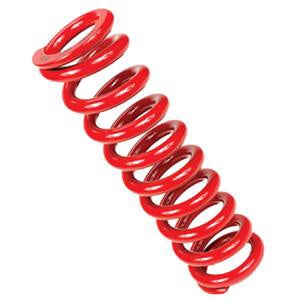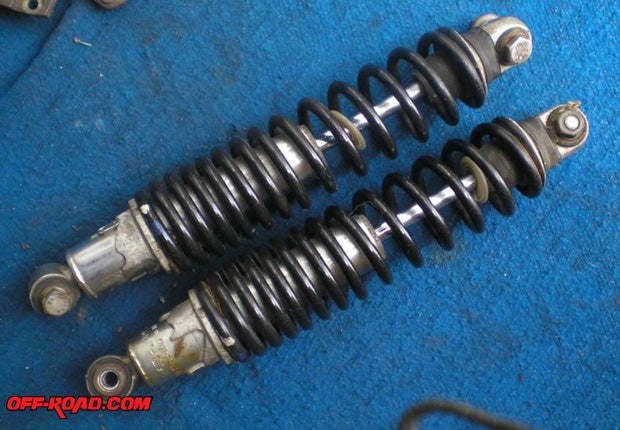 But if you're like a lot of vintage bike riders, you want to use the original shock spring to make the bike totally correct. This means that you have to go through whatever pile of garbage you might have your garage, or around your buddy’s garage, for the correct spring.
But if you're like a lot of vintage bike riders, you want to use the original shock spring to make the bike totally correct. This means that you have to go through whatever pile of garbage you might have your garage, or around your buddy’s garage, for the correct spring.
But even if you know what brand of spring you're looking for, how are you going to tell if this spring has the correct rate for your bike’s needs? So you look through one pile of garbage after another pile of garbage searching for the mystical perfect spring.
Garbage has a certain subtle way of building up in the garage, but of course, none of it is really pure garbage – just junk you'll probably never use again. Like all the fouled spark plugs, seized pistons and bent rims I have hanging from the ceiling in a metal "mobile," it's a still a piece of junk, plain and simple.
On the other hand, there are various items that are actually valuable. Like all those shock springs that are in the box along with broken hubs (real junk) and the paper air cleaners that used to come stock on your dirt bike (more real junk). Admittedly, these springs are close to being useless, because you don't really know the spring rate on them.
Here's the answer to the prayers you didn't know you were saying. For the first time in the annals of motorcycling jour¬nalism, fresh off the press, is a spring rate color guide conversion chart for really old shocks. But read on for a few details so that you learn to use the chart and not mistake a progressive rate spring for a single rate.
This chart will give you a great starting point and help identifying all those old springs. No longer are you now dealing with an unknown pile of garbage; you will have an identifiable pile of garbage.
 First off, I'll assume you know the brand of the springs you have. In appearance, the springs are the same, so there is no sure method of identifying them.
First off, I'll assume you know the brand of the springs you have. In appearance, the springs are the same, so there is no sure method of identifying them.
Owners of those funny looking red shocks called Curnutts might be getting panicky because they have already sneaked a peek at the chart and didn't see them listed, There's a good reason: All Curnutt springs, except the ones that go on mini bikes, are the same spring rate. This spring rate is about 45-55 progressively wound. Curnutt designs the shocks this way, and the company only changes the internals to suit different bikes.
Koni owners are in the same predicament of not having their springs listed. Konis come with only a couple of different spring rates available, and these aren't color coded. On the side, the Koni dealer confided that most Koni owners, if they want to switch springs, go to the S&W items for replacements.

Another very popular shock, Mavricks, are also not listed. Maverick, unlike Koni, had a full line of spring rates available, but for reasons beyond our com¬prehension, they don't color code them. To get different springs you have to hope the company sends you the right ones. There's a nasty rumor going around, one which we'll choose to ignore, that Maverick didn't mark their springs for one low-down reason: if someone orders, say, an 88-pound spring, and they're out of them, they merely substituted an 82-pound spring. Nah, couldn't be true.
Now, for the chart itself. Pull out your springs, maybe those Arnacos, and look at the color. Red. OK. Look on the chart under Arnaco and go down to red. Uh huh, 90 pounds. Simple, isn't it? Until you get to something like your S&W springs that are plain. Well, the only S&W spring that is plain happens to be a 60-pounder. All others on this chart have color on them.
Next, some companies make more than one spring in a certain rate. In that case, break out your ruler and measure the things. Just like before, look up the brand and go to the color, but this time you'll also have to look at the length.
Another little quirk which I believe happens only under the S&W column, is the production of a spring specifically for a certain shock. S&W makes springs speci¬fically for Girlings and uses their color code. Just to make things easier, I listed the code twice and next to the code I listed the brand name Girling if it was just for that shock. For example, your S&W's are yellow-yellow. Go down that column and you'll see they are 75-pound, made just for Girlings.
Finally, to separate progressive-wound shocks from single rate, I listed progressives under the rate at which they start; e.g.. 60-90 Boges, which happen to have red on them, are listed only under the 60 column.
OK, rummage through your junk pile and see what you come up with.


 Your Privacy Choices
Your Privacy Choices